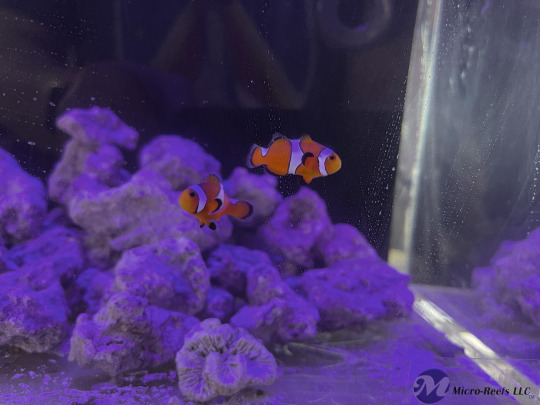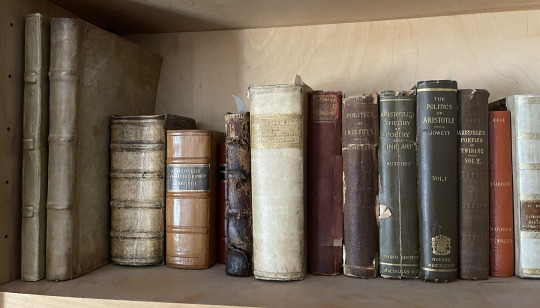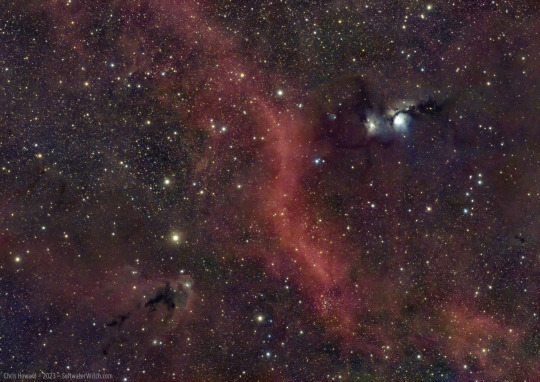Text
This beautiful bird landed in the yard today. I'm guessing a Northern Goshawk?
2 notes
·
View notes
Text

New leaves on the red mangrove trees in the reef tank.
1 note
·
View note
Text

A small colony of Zoanthus sociatus in the new tank. I have slowly brought the lights up--over the week--to where I want the intensity, and it was time to take a few pics. Zoanthids are my favorite corals--my favorite Cnidarians--some of you may know this, been keeping these little animals (and a lot more) in aquariums since the 1980s. Imaging notes: Nikon D750, 85mm at f/5.6, 1/125 sec, ISO 720.
1 note
·
View note
Text

Sorry for the dirty glass--actually that's 1/2 inch acrylic. Not much happening in this new tank so far, no one around except these two clowns.
1 note
·
View note
Text

One of a series of watercolor kelp pieces I painted a while back. Just browsing some old art folders and finding some cool stuff.
6 notes
·
View notes
Text

I started cycling a new coral reef aquarium on Thursday (Leap Day), dosed with Ammonium Chloride and cultured nitrifying bacteria. (Nothing in the tank right now except some dead coral rubble and biological media in the filter flow). I checked the chemistry today and it's looking pretty active on Ammonia being converted into Nitrite (NO2) by Nitrosomonas sp., and there's even some conversion from NO2 into NO3 (Nitrate) by Nitrospira marina, et. al. I have bumped up the temperature to 80F/27C and I'm running salinity slightly lower at about 30 PPT / 1.023 relative specific gravity. Nothing alive in the tank right now--and for the next couple months, except the bacteria. Release the chemolithoautotrophs!
0 notes
Text

A shot of a mix of zoanthids (or palythoans) from my reef aquarium--this is an old one from 2017. These guys are some of my favorites. One of these days I'd like to start a zoanthid-only tank like some of the really beautiful corallimorph tanks out there.
1 note
·
View note
Text

Just doing a little research.
2 notes
·
View notes
Text

Last day of the holiday and I just passed 35,000 words on a new novel--something new I've been thinking about for a while, no connection to any of my previous books. My goal is to complete a first draft around March and refine from there.
Hope everyone had a happy New Year!
Nothing I am currently writing has anything to do with Aristotle, but if you're wondering about the image: that's a small section of the wall of bookcases full of books behind me where I sit at my desk. I used to collect Aristotle's works--I have 200+ books by, on, and about Aristotle on the shelves. That folio-sized one, second from the left is my Madius edition of Aristotle's Poetics, published in Venice in 1550. (Vincentii Madii Brixiani et Bartholomaei Lombardi Veronensis in Aristotelis librum De Poetica communes explanationes: Madii vero in eundem librum propriae annotationes) https://www.SaltwaterWitch.com
2 notes
·
View notes
Text

It's lunar photography tonight, with an 83% waxing moon. Here's one of my shots. I'm out with the 8" Newtonian, 800mm FL at f/4 and the ZWO ASI715MC color camera. This is my first experience with the 715, so far so good! More of my astro stuff here: https://SaltwaterWitch.com
#astrophotography#astronomy#saltwater witch#backyard astronomy#night sky#luna#lunar photography#moon
4 notes
·
View notes
Text

Astrophotography from my backyard--from last night's imaging run: M78, LDN 1622, and a piece of Barnard's Loop. Top right is a structure composed of a batch of dark nebulae clustered around the reflection nebula Messier 78 (M78, NGC 2068), about 1,350 lightyears away, and bottom left is LDN1622, the "Boogeyman Nebula" about 500 lightyears away. And the wide ribbon running between them, mostly ionized hydrogen and interstellar dust, is part of "Barnard's Loop", which runs around the Alnitak side of the constellation Orion.
Imaging Notes: 49 x 300-second subs taken with the ZWO ASI071MC color camera (cooled to 0°C, gain 0) and the William Optics Redcat 51 apochromatic refractor (250mm FL, f/4.9), Sky-Watcher EQ6-R Pro mount, ZWO ASIAir Plus astro controller. I shot 94 sub-expsures at 5-minutes each, starting around 7pm and running through the night to about 4am, but ended up tossing almost half of them, stacking the best 49.
https://SaltwaterWitch.com
12 notes
·
View notes
Text

The astro gear is ready to go (this is the advantage of being able to leave everything setup for weeks at a time). Now I'm just waiting for the clouds to move.
0 notes
Text

Galaxies in Ursa Major, wide-field view from my back yard of Bode's Galaxy (M81, NGC 3031) and the Cigar Galaxy (M82, NGC 3034) about 12-million lightyears away in Ursa Major (the "Big Dipper"). There are a bunch of other galaxies in this view, including NGC 3077 and NGC 2976. The clouds and interstellar dust are in our galaxy and are lit by the surrounding starlight. Imaging Notes: 73 x 300-second sub-exposures taken with the William Optics Redcat 51 apochromatic refractor, ZWO ASI071MC color camera cooled to 0°C at Gain 0.
1 note
·
View note
Text

The Pleiades, M45, also called the Seven Sisters, is a very bright and distinct open star cluster in Taurus, surrounded by the reflection nebula NGC 1432 (most of that pale blue interstellar dust and cloudiness). The Seven Sisters are very hot blue stars about 444 lightyears away. Where I am in the northern hemisphere, around 43° latitude, the Pleiades rises in the night sky in October, peaks in January at almost 50° in the southern sky, before sinking below the horizon by the end of March—and then we don't see it in the night sky again until late autumn.
To the ancient Greeks, over 2,500 years ago, the rising of the Pleiades marked the start of shipping season, when sailing the Mediterranean was a bit less dangerous. Like a lot of ancient mariners, Ancient Greek sailors and navigators relied on astronavigation, using the stars to determine their precise position on the surface of the earth. An ancient Athenian ship could leave the Piraeus and sail directly out to sea, then head west, toward Syracuse, tracking the stars the whole way to determine their course. They would also be keeping track of the Pleiades' position in the sky each night, and use that to determine if they should pick up cargo and make the return trip or pick up some local coastal work through the summer and return to Athens in the fall.
Imaging Notes: 71 x 5-minute sub-exposures stacked in PixInsight. ZWO ASI071MC color camera cooled to 0°C, Gain 0, Antlia V-Series Luminance/UV-IR Cut filter, William Optics RedCat 51 Apochromatic Refractor 250mm FL, f/4.9, Sky-Watcher EQ6-R Pro mount, ZWO ASIAir Plus astro controller.
0 notes
Text

I setup the wide-field color rig at lunch and now I'm waiting for sunset. Going with the ZWO ASI071 cooled color (APS-C sensor) camera and an Antlia UV-IR cut filter. No moon tonight, so if we get a stretch of clear seeing, I'm going after M45 (the Pleiades) for half the night, and then I'll spend the rest on M78 in Orion. Hope the weather holds!
More of my astro stuff here: https://www.saltwaterwitch.com
#saltwater witch#astrophotography#astronomy#backyard astronomy#narrowband imaging#zwo#orion nebula#Pleiades
13 notes
·
View notes
Text

Orion Core in hydrogen-alpha: two-panel mosaic of Orion's Belt, the Horsehead Nebula, and M42, the Orion Nebula--and everything going on around these. This is a big chunk of space and the center of the Constellation Orion. The three bright stars in a line on the left is Orion's Belt. ZWO ASI2600MM-Pro, 3nm Ha, William Optics SpaceCat51 Apo refractor. My astro stuff here: https://SaltwaterWitch.com
22 notes
·
View notes
Text

Well, that worked pretty well for an 88% waxing moon with the ZWO ASI071MC color camera. The near-full moon and Jupiter at opposition were just far enough away to make this set up work--plus a lot of 5-minute exposures. That band of red at the top left is the tail end of the ridge of hydrogen that runs behind the Horsehead Nebula (B33). Imaging notes: 63 x 300-second subs, no filters with the ZWO ASI071 color camera cooled to 0C, William Optics RedCat 15 Apo refractor, Sky-Watcher EQ6-R Pro mount. The Orion Nebula (M42), Running Man Nebula (Sh2-279), De Mairan's Nebula (NGC 1982,M43), and surrounding nebulosity.
More of my astro stuff here: https://SaltwaterWitch.com
32 notes
·
View notes